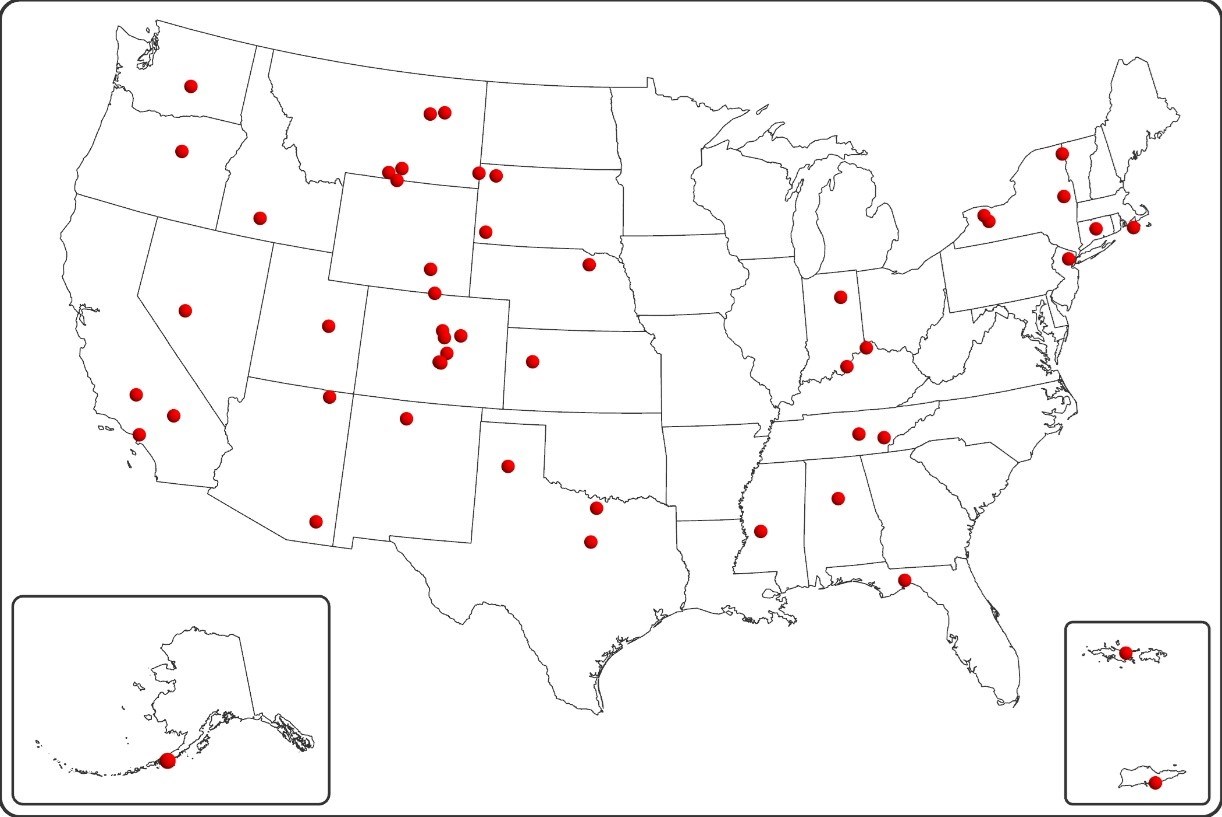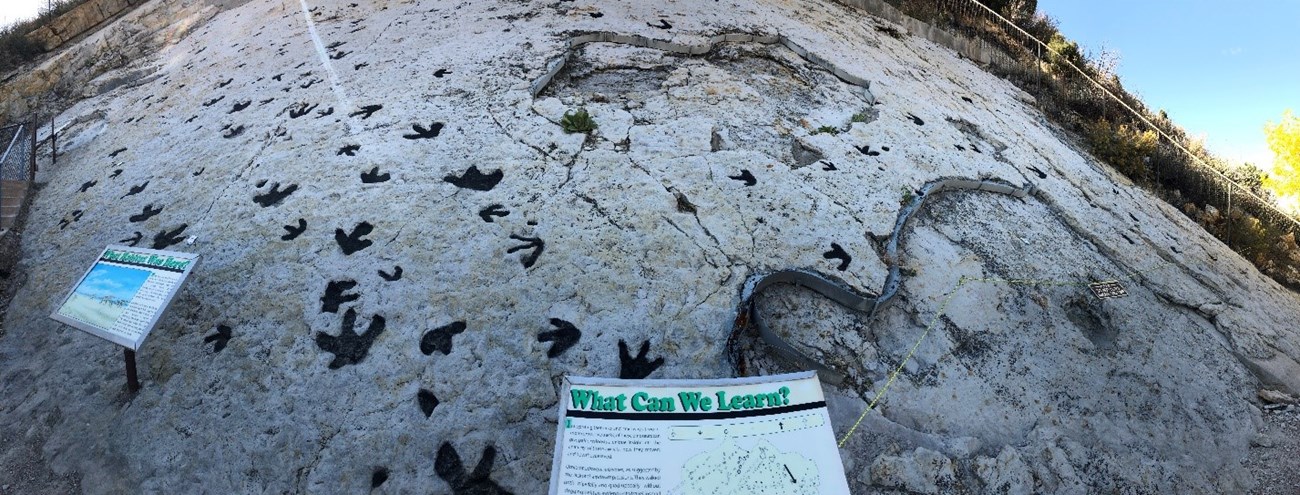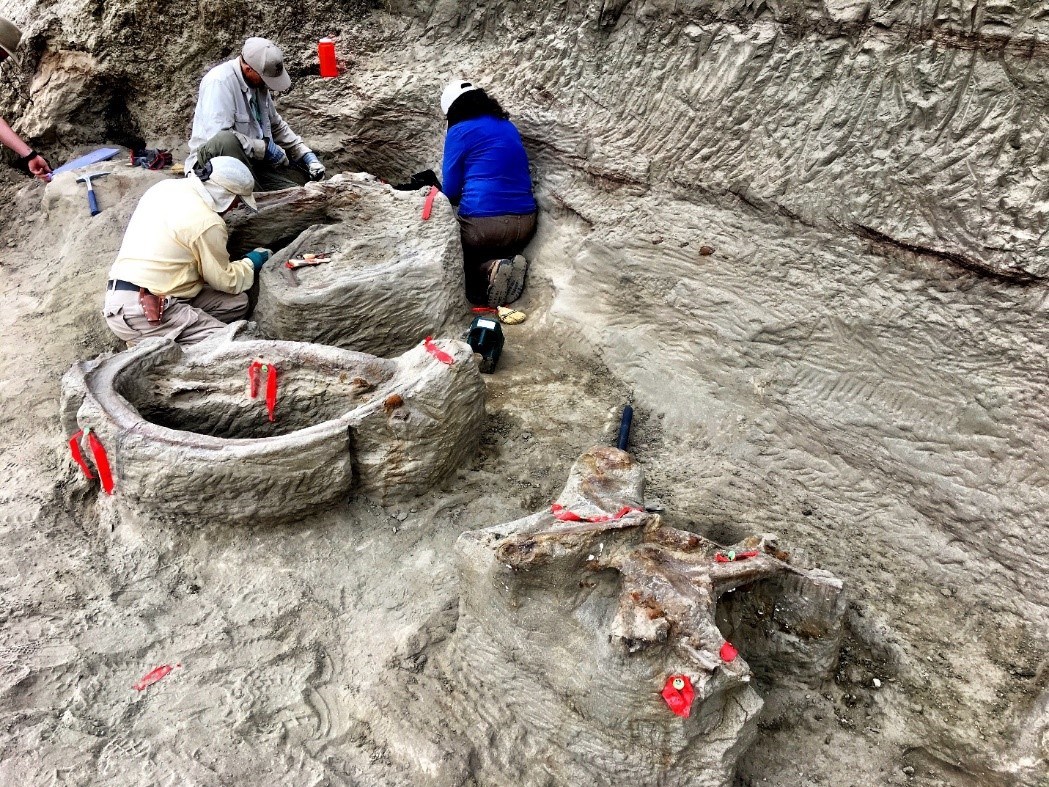Part of a series of articles titled Park Paleontology News - Vol. 12, No. 1, Spring 2020.
Article
Preserving Fossils: How the National Natural Landmarks Program Advances Resource Management

Lakewood, Colorado
The National Natural Landmark Program (NNL), part of the National Park Service’s Natural Resource Stewardship and Science directorate, designates sites for significant paleontological features. These places represent more than just a collection of specimens and in-situ fossils; their influence on science and culture within the United States and across the world cannot be understated. Paleo discoveries made at NNL sites have heavily influenced popular culture, caused paradigm shifts in public thinking, and changed the course of paleontology as a science.
One of the first paleontological discoveries made by a European within the U.S. was a collection of mastodon skeletons at Big Bone Lick NNL in Kentucky in 1739. While the site was known to indigenous people, it is one of the earliest sites to shape the science of paleontology. French scientist, Georges Cuiver, described Big Bone Lick as the best evidence of extinction to date, a revolutionary concept at the time. Jefferson and other leading naturalists of the day believed in the idea of the “Great Chain of Being” which blended Christianity with science (Liggett, 2018). The basic tenets of this philosophy are that every plant and animal have its place in a divine hierarchy, and that extinction would oppose the idea of an infallible God (Nee, 2005). As such, Jefferson believed that mastodon must still exist somewhere in the New World, and it simply had not yet been found. Early expeditions in the American West were tasked with finding living mastodons. After coming home with a fossil from their famous expedition, William Clark was dispatched to Big Bone Lick to bring Thomas Jefferson more bones for him to study (Liggett, 2018). Heralded as the birthplace of North American vertebrate paleontology and designated an NNL in 2009, Big Bone Lick is one of many NNLs that have made indelible marks within the paleo history pages of our country.

NPS photo.
Westward expansion throughout the 1800s brought more dinosaur discoveries. Perhaps the most famous finds were during the dinosaur rush, aka the Bone Wars, of the 1870s-1890s. Edward Drinker Cope and Othniel Charles Marsh’s bitter rivalry and race to discover the next great saurian specimen ignited public interest in paleontology (PBS, 2016). Secrecy, theft, and ego surrounded their dig sites and specimens. Many of these notorious quarries are designated as NNLs. The Morrison-Golden Fossil and Garden Park Fossil Areas in Colorado, and Como Bluff in Wyoming, were among the most productive quarries of the time, filling museums across the globe with fine specimens of the Jurassic Period.
While significant discoveries were made at NNLs in the early- to mid-1900s at the La Brea Tar Pits in California and Ghost Ranch in New Mexico, the next paradigm shift in paleontology can be traced to John Ostrom and Robert Bakker’s findings across Wyoming and Montana. The Cloverly Formation Site, Bridger Fossil Area, and Crooked Creek Natural Area NNLs are the quarries where the Deinonychus antirrhopus was first unearthed. This “unusual theropod” was a key piece in understanding how flight in animals developed (Ostrom, 1969). While there was no fossil evidence of a feathered Deinonychus at these sites, the anatomical similarities to the Archaeopteryx (early avian dinosaur with fossil evidence of feathers) were clear to Ostrom- most notably the fused clavicle that provides the necessary shoulder support and strength for flight. In addition to providing evidence of the link between dinosaurs and birds, the Deinonychus helped Robert Bakker support the theory that some dinosaurs were warm-blooded and much more active than the accepted dinosaurian behavior model at the time (Bakker, 1975). The Deinonychus was the star in the Jurassic Park books and films, although the author, Michael Crichton, preferred the name of its relative Velociraptor despite consulting with Ostrom while writing the books.
John Ostrom was more than a pioneering paleontologist. In the late 1960s, he guided the National Park Service by writing the paleontology theme study for the recently created National Natural Landmarks Program. Ostrom recommended 20 sites to be designated as NNLs to help protect these important places. Thirteen of those sites went on to become designated landmarks and are in excellent condition with little to no degradation to their paleo resources.

Photo courtesy of the Manchester Historical Society.
Unfortunately, one of the sites that John Ostrom recommended for NNL designation that did not become a landmark suffered a different fate. The Charles O. Wolcott Quarry, a privately-owned stone quarry near Manchester, Connecticut, was one of New England’s most productive paleo sites. Despite Ostrom’s best attempts at rallying public support for the site, it was bulldozed and destroyed in 2000 to construct a shopping mall and highway. Ostrom, 72 years old at the time, searched through the construction debris as these valuable deposits were dynamited around him (Gentile, 2000). While this was his final attempt at saving the site, it was not his first. In the late 1960s, Ostrom surveyed more than 60 bridges in the area to find the missing stone blocks from the quarry that contained dinosaur bones. Miraculously, he found the bridge just before it was dismantled by the highway department. Miraculously the highway department agreed to donate the stone blocks to Ostrom, and his team was able to locate multiple dinosaur fossils (Williams, 2020).
This example reminds us that our nation’s significant paleontological features exist on both public and private lands, and the importance of exploring different ways to come together to support their protection, where possible. National Natural Landmark designation is one way to identify and recognize significant natural features in both public and private ownership. Designated sites are afforded national awareness and recognition, and the opportunity for the National Park Service to work alongside those site owners and managers to encourage and support conservation.
NNLs with Fossil Resources
Currently, there are 50 National Natural Landmarks designated wholly, or in part, for their nationally significant paleontological resources.
NPS image.
Red Mountain Expressway Cut, Alabama
Comb Ridge, Arizona
Willcox Playa, Arizona
Rainbow Basin, California
Rancho La Brea, California
Sharktooth Hill, California
Garden of the Gods, Colorado
Garden Park Fossil Area, Colorado
Indian Springs Trace Fossil Site, Colorado
Morrison-Golden Fossil Areas, Colorado
Roxborough State Park, Colorado
West Bijou Site, Colorado
Dinosaur Trackway, Connecticut
Wakulla Springs, Florida
Hagerman Fauna Sites, Idaho
Hanging Rock and Wabash Reef, Indiana
Ohio Coral Reef (Falls of the Ohio), Indiana and Kentucky
Monument Rocks Natural Area, Kansas
Big Bone Lick, Kentucky
Gay Head Cliffs, Massachusetts
Mississippi Petrified Forest, Mississippi
Bridger Fossil Area, Montana
Bug Creek Fossil Area, Montana
Capitol Rock, Montana
Cloverly Formation Site, Montana
Hell Creek Fossil Area, Montana
Ashfall Fossil Beds, Nebraska
Riker Hill Fossil Site, New Jersey
Ghost Ranch, New Mexico
Ichthyosaur Site, New York
Fall Brook Gorge, New York
Fossil Coral Reef, New York
Petrified Gardens, New York
Chazy Fossil Reef, New York and Vermont
John Day Fossil Beds, Oregon
Mammoth Site of Hot Springs, South Dakota
The Castles, South Dakota
Big Bone Cave, Tennessee
Lost Sea (Craighead Caverns), Tennessee
Dinosaur Valley, Texas
Greenwood Canyon, Texas
Palo Duro Canyon State Park, Texas
Cleveland-Lloyd Dinosaur Quarry, Utah
Coki Point Cliffs, Virgin Islands
Vagthus Point, Virgin Islands
Ginkgo Petrified Forest, Washington
Como Bluff, Wyoming
Crooked Creek Natural Area, Wyoming
Sand Creek, Wyoming and Colorado
The NPS furthers the preservation of these paleo resources by partnering with landowners to assist their conservation efforts. The following examples of recent assistance projects illustrate some of the many ways the NPS can assist with resource conservation, thereby advancing the NPS Mission to extend the benefits of resource conservation throughout this country.
Foundation Planning at Morrison-Golden Fossil Areas, Colorado
Dinosaur Ridge, part of the Morrison-Golden Fossil Areas NNL located west of Denver, is facing pressure from rapid population growth and upcoming development. During construction planning meetings in early 2019, site managers became aware that they could benefit from a strategic planning exercise to better articulate the significance of the site and why the development needs to factor the paleo resources in their design plans. It was also important that the process bring the county (the landowner) and the friends’ group (the site manager) together to reach shared conservation and interpretation goals.

NPS photo.
The National Park Service’s Foundation Planning framework was the ideal method to help the county and friends’ group focus and align their efforts on Dinosaur Ridge. In Spring 2019, NNL Program staff facilitated a Foundation Planning workshop, much like those conducted at park units all across the country, to identify and describe the condition of the site’s fundamental resources, articulate the site's significance, improve resource interpretation, and identify other important resources and values. The Six Fundamental Resources were identified as: 1) the main tracksite, 2) Brontosaurus bulges, 3) Crocodile Creek, 4) raptor track, 5) bone quarry #1, and 6) bone quarry #5. Further, visitor experience will be improved with new interpretative panels and refreshed messaging. The workshop helped both stakeholders identify and prioritize specific features on the landscape to ensure long-term preservation of the ridge’s most important features.
Educational Paleo Film Series at Sites Across the Rocky Mountains
The NNL Program partnered with the Natural Resource Stewardship and Science’s Office of Communications to create an educational film series about dinosaurs found in landmarks in and along the Rocky Mountain Front. The dinosaur story was divided into the three time periods of the Mesozoic Era and sought to balance science lessons with fun, light-hearted clips and graphics to keep viewers entertained.

NPS photo.
Highlights of the project included filming the active Tufts-Love Tyrannosaurus rex dig site in Montana’s Hell Creek formation and interviewing prominent paleo experts, including Mike Leschin, BLM Paleontologist at the Cleveland-Lloyd Dinosaur Quarry in Utah, and Alex Downs, at Ghost Ranch, NM, catching them both just prior to retirement. Both energetic paleontologists managed their respective quarries for nearly 20 years, and it was an honor to capture their thoughts on these important places in the twilight of their careers. The films also feature one of the National Park Service’s newest paleontologists, ReBecca Hunt-Foster. At the time of the filming, she worked in Moab, UT for the BLM before joining the team at Dinosaur National Monument. The video series can be found on the “multimedia” page of the National Natural Landmarks Program website www.nps.gov/nnlandmarks.

NPS photo.
Geologic Timescale Artwork

NPS image
The NNL program produced a new and beautiful take on an ancient topic- the geologic time scale as represented though fossils at Landmarks. This educational poster, measuring 8x26”, is gear towards the general public and seeks to raise awareness of the diversity of NNL sites with significant fossil resources. Spanning from Precambrian to Cenozoic, the poster tackles the complexity of the geological time scale while featuring original illustrations of paleontological resources from select NNLs. The NNL Program collaborated with artist Dennis Caldwell, based in Tucson, Arizona. His work brought life to fossils such as wooly mammoth, Hagerman horse, ichthyosaur, trilobite, sauropod, allosaurus, and more. This poster will be available to NNL landowners and managers, included in the American Geosciences Institute 2020 Earth Science Week educator toolkits, and utilized for outreach events such as National Fossil Day. Contact the NNL Program Manager, Heather Eggleston for a copy of the poster.
Works Cited
- Bakker, R. (1975, April). Dinosaur Renaissance. Scientific American, pp. 58-79.
- Gentile, O. (2000, June 23). The Forgotten Fossils. Hartford Courant.
- Liggett, G. A. (2018). From Public Lands to Museums: The foundation of US paleontology, the early history of federal public lands and museums, and the developing role of the US Department of Interior. Geological Society of America, pp. 313-321.
- Nee, S. (2005, May 26). The Great Chain of Being. Nature, p. 429.
- Ostrom, J. H. (1969). Osteology of Deinonychus antirrhopus, and Unusal Theropod from the Lower Cretaceous of Montana. New Haven, CT: Peabody Museum of Natural History, Yale Univerisy.
- Ostrom, J. H. (1969). Report to the National Park Service on Mesozoic Vertebrate Paleontological Sites for Possible Inclusion in the Registry of Natural Landmarks. New Haven, CT: Peabody Museum of Natural History, Yale University.
- PBS. (2016). OC Marsh and ED Cope: A Rivalry. American Experience.
- Williams, D. B. (2020, February 20). Mystery Solved: Bones found in Bridge. Retrieved from GeologyWritter.com: http://geologywriter.com/blog/stories-in-stone-blog/mystery-solved-bones-found-in-bridge/
Last updated: March 9, 2020
